Major and Minor Scales
Music is patterns of sound.
Two fundamentals in music are rhythm patterns (how combinations of long and short notes relate to a steady beat or pulse) and pitch patterns (what notes are played).
The specific pitches used in a piece of music are usually derived from a scale.
The most common type of scale is the major scale.
On the piano, we can play the C Major Scale using only the white keys – C D E F G A B C. A piece of music composed using the notes of the C Major Scale is said to be in the Key of C.
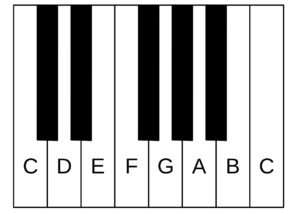
On the guitar that looks like:
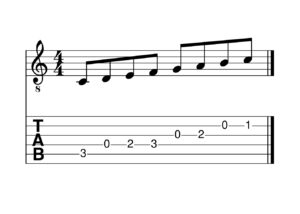
When we play only white keys from C to C, we are actually playing an uneven pattern of steps (also called tones) and half-steps (also called semi-tones).
Notes that are a step apart have one key between them. There is a black key between C and D, so they are a step apart. On the guitar, a step is 2 frets, from example, from C on the 2nd string 1st fret to D on the same string 3rd fret.
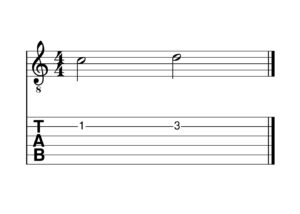
A half-step is the distance from any key to the key directly beside it. Most half-steps go from a white key to a black key. However, there are two pairs of whites keys that don’t have a black key between them, so are a half step apart. These are E to F and B to C. On the guitar, a half-step is 1 fret apart, for example, from open E on the 1st string to the 1st fret of the same string.
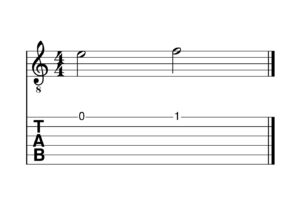
The C Major Scale demonstrates the pattern that all major scales follow:
From C to D is a step.
From D to E is a step.
From E to F is a half-step.
From F to G is a step.
From G to A is a step.
From A to B is a step.
From B to C is a half-step.
All major scales follows this pattern:
Step, Step, Half-step, Step, Step, Step, Half-step
Many people find that the major scale sounds happy, or uplifting. If the pattern of steps and half-steps is altered, it changes the sound of the scale. One common relative of the major scale is the natural minor scale, which can sound sad or wistful.
The natural minor scale is made by rearranging the notes of the major scale:
Step, Half-step, Step, Step, Half-step, Step, Step
The A Natural Minor Scale uses only white keys on the piano.
From A to B is a step.
From B to C is a half-step.
From C to D is a step.
From D to E is a step.
From E to F is a half-step.
From F to G is a step.
From G to A is a step.
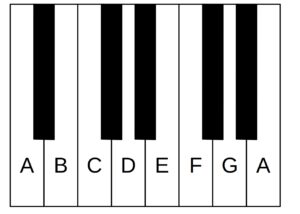
On the guitar the A Natural Minor scale looks like:
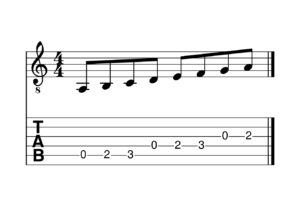
Because the C Major Scale and the A Minor Scale both use only natural notes, they are called relative major and relative minor. Each major scale has a relative minor (See The Circle of Fifths for the pairing of major and minor keys/scales).
Natural minor scales are sometimes further altered to create greater harmonic complexity.
Two common alterations are the harmonic minor and the melodic minor.
The harmonic minor scale is made by sharpening the seventh note of the natural minor scale. In the case of A Minor, that would mean replacing G with G#.
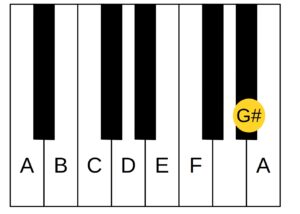
This makes a pattern that includes a step and a half between the 6th and 7th notes, and a half-step between the 7th and 8th notes.
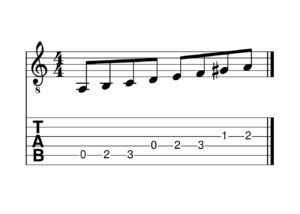
From A to B is a step.
From B to C is a half-step.
From C to D is a step.
From D to E is a step.
From E to F is a half-step.
From F to G# is a step and a half.
From G# to A is a half-step.
The melodic minor scale is made by sharpening both the sixth and seventh notes of the natural minor scale. In the case of A Minor, that would mean replacing F with F# and G with G#.
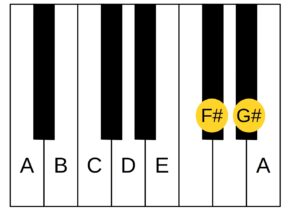
This pattern gets rid of the step and a half of the harmonic scale, instead having four steps in a row, and finishing with a half-step.
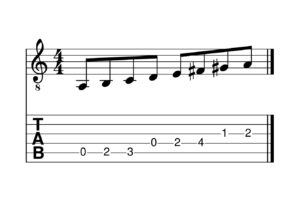
From A to B is a step.
From B to C is a half-step.
From C to D is a step.
From D to E is a step.
From E to F# is a step.
From F# to G# is a step.
From G# to A is a half-step.
It is common to play the notes of the melodic minor when ascending, and to play the notes of the natural minor when descending.
I am currently in the process of making sheet music for all common piano and guitar scales. So far I have completed one octave major and minor scales for guitar, and one octave major scales for the piano. There will be more scales posted in the coming weeks.
Guitar
Major Scales
Minor Scales
Piano
Major Scales